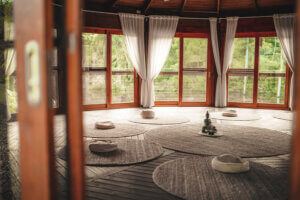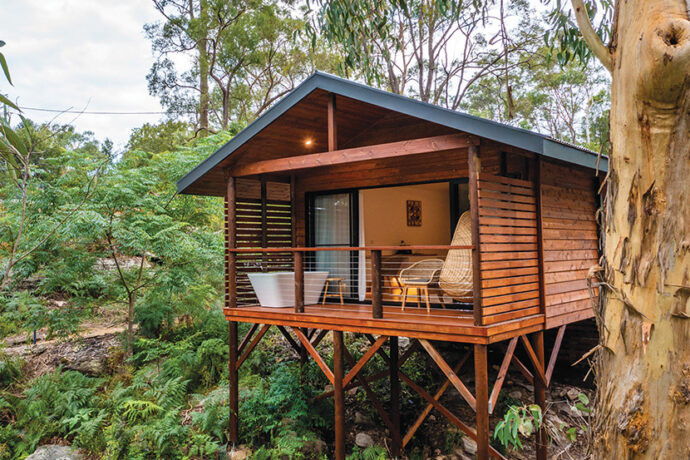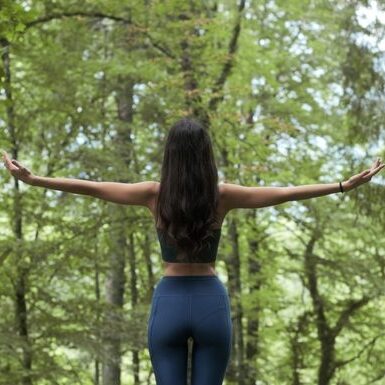More inspiring stories
Mythbusting: Gut health
If you want to get your gut in order, Dr Will Bulsiewicz is the expert to help you sort out fact from fiction. This is the gut-health cheat sheet...
Plant-based recipe inspiration
Butter bean smash with roasted mushrooms
Creamy beans with a hint of lemon are the perfect base for delicious, garlicky mushrooms.
Tempeh spaghetti Bolognese
When you focus on wholefood, plant-based ingredients, you’ll get plenty of fibre while still enjoying all your favourites. This...
Pumpkin chai doughnuts
There’s nothing quite like a freshly-baked homemade doughnut, and these delicate chai-spiced delights made with spelt flour and pumpkin puree...
Mulberry cordial
There’s no artificial anything in this bright, refreshing four-ingredient mulberry cordial. Serve on ice with a sprig of mint for the ultimate...
Reishi truffles
Reishi is a medicinal mushroom with a reputation for being a profound immune stimulator. In powder form, you can enjoy it added to chocolate,...
Creamy quinoa porridge with stewed plums
Quinoa is gluten free, high in protein and fibre, and is low GI, meaning it is slowly digested for longer-lasting energy.
Beetroot borani
This delicious yoghurt dip is so simple to make and will definitely keep you coming back for more!
More inspiration from our mindful collective
Natural sleep oils
Spraying sheets and pillows with calming scents can be a wonderful aid to slumber
To wander with no purpose
The next time you go for a walk, discover the wonder of the everyday world around you
Let it glow
A skincare routine can be a way to nourish yourself inside and out
Seeking the silver lining
When the clouds converge, practise gratitude for the smallest of glimmers, and learn to dance in the rain.
Mindful escapes with Billabong Retreat
In the fast-paced and demanding world we live in, finding moments of stillness and calm can be challenging. In an attempt to find a little peace and quiet, Mindful Puzzles’ own Nicole Kennedy set off for a weekend of self-care.
The afternoon winter light filtering through the trees gave the hinterland a calm, quiet glow, and as I sat, nestled in a blanket with a cup of tea in hand, watching the sun slowly sink towards the horizon, I truly felt like the rest of the world was, well, a world away. I had come to Billabong Retreat to reflect and recharge, and from the very first moments I knew that this would be the place to do it.
The location

Approximately 45 minutes from Sydney and a little over an hour from my home on the Central Coast, the beautiful Billabong Retreat is located on 12 acres of stunning Australian bush abundant with native flowers, birds, and other local wildlife. The billabong after which the retreat is named is adorned with bright lily pads and you can tell just by looking at it that it is a haven for the creatures that call it home.
With a vision to create a space where people could come to reconnect to nature and the life within and around them, Billabong Retreat certainly is a place to find peace of mind and body. Nestled in the trees, the complex has a sprawling treehouse feel, and the communal meeting and sharing space is adorned with a large, comfy lounge and cosy armchairs, all decked out with cushions and throw blankets around a combustion fireplace. The retreat’s eco-friendly architecture blends seamlessly with the landscape, creating a warm and inviting atmosphere, and I was impressed by the clear commitment to sustainability and attempts to minimise the retreat’s ecological impact.
Digital detoxing & self-reflection

I arrived on Friday afternoon after a long week and was immediately captivated by the simple beauty of it all, eager to let go and sink into the serenity. The ‘no mobile phones in the communal areas’ rule was particularly exciting, not because of any personal addiction to social media but for the simple excuse to be relieved of my normal responsibilities. After being warmly greeted at reception and given the grand tour, I joined a guided meditation session where I was encouraged to cultivate awareness of the present moment and allow myself the chance to observe thoughts and emotions without judgement. After that, I was free to wander and explore in whatever way I saw fit.
Activities: Yoga & mediation

From yoga and meditation essentials to help guests find stillness and calm, to programs about stress relief and how to live mindfully, Billabong Retreat offers a range of different options for people to focus on their different needs. The retreat program I booked into was called Taking Care of You, with a focus on self-care and what it means for the mind, body, and spirit, and included workshops about caring for ourselves and daily yoga and meditation sessions. Saturday dawned and from a cosy spot in the comfortable bed in my treehouse cabin, I watched the sun rise over the billabong. I was looking forward to the day’s workshop and the promise of connecting with like-minded strangers – as well as breakfast, which after the delicious dinner of the previous night I knew would nourish my body and soul.
The menu

The wholefood, plant-based menu was delicious as well as nutritious and I appreciated the philosophy that underpins the retreat’s approach to food: that good nutrition is one of the foundations of good health and longevity, and it shouldn’t be complicated. I particularly appreciated the obvious passion that the chefs had for their craft – our dining experiences were prefaced with an explanation about the fresh and locally sourced ingredients and you could just about taste the care and dedication that went into the creation of each meal. Mealtimes were not just about nourishing our bodies but also provided an opportunity for connection and camaraderie. As we sat together, sharing stories and laughter, we formed a bond, albeit fleeting, as we realised that we were all on this journey of self-care and self-discovery together.
Finding relaxation through self-care
Relaxing – that is, the art of doing nothing much at all for no real purpose – has never come particularly easy to me. Attempting to unwind can often become its own ordeal – I usually end up worrying about all the other things I could be doing, all the responsibilities, or, at least, the perceived responsibilities, that I’m overlooking. Turns out, I’m not alone in this frustrating paradox, as I learned during the self-care workshop. Many of the other participants, from mothers of small children to businesspeople caught in the corporate rat race, shared the feelings of guilt and stress that they experienced upon trying to relax. We were reminded that self-care doesn’t have to be a fancy indulgence or in any way convoluted, and it isn’t something we should do once we’re already stressed or need to recharge. Instead, self-care should become part of a regular, everyday routine – as second nature and ordinary as brushing your teeth.
For more information about Billabong Retreat, visit billabongretreat.com.au
The writer was a guest of Billabong Retreat.
More inspiring stories
Mythbusting: Gut health
If you want to get your gut in order, Dr Will Bulsiewicz is the expert to help you sort out fact from fiction. This is the gut-health cheat sheet...
More inspiration from our mindful collective
Natural sleep oils
Spraying sheets and pillows with calming scents can be a wonderful aid to slumber
To wander with no purpose
The next time you go for a walk, discover the wonder of the everyday world around you
Let it glow
A skincare routine can be a way to nourish yourself inside and out
Seeking the silver lining
When the clouds converge, practise gratitude for the smallest of glimmers, and learn to dance in the rain.
The health benefits of forest bathing
Your guide to the Japanese practice of shinrin-yoku and its incredible therapeutic benefits.
Shinrin-yoku, literally ‘taking in the forest atmosphere’, is a Japanese term for the cultural practice known the world over as forest bathing. Forest bathing became a part of Japan’s national public health program in 1982, and the Japanese government has spent millions on scientific research into the practice’s physical and psychological health benefits.
While you might think forest bathing consists of stripping off and swimming in the woods, it’s actually a lot simpler – purely spending time in the bush or any natural landscape will meet the requirements. Any time you walk among trees without distractions or hurrying, ideally for two hours or more, you’re forest bathing.
So what’s the catch? That’s just it – there isn’t one. Just be with trees. No hiking, no counting steps on a Fitbit. You can sit or meander, but the point is to relax rather than accomplish a specific goal.
Simply find a spot with lots of trees, and take a long, slow walk.
Your next question will probably be: but what good will it do? Thanks to the studies begun in Japan and continued by research facilities in the United States and Europe, there have been numerous investigations into the physical and psychological health benefits of forest bathing.
A study conducted at Japan’s Chiba University compared nearly 300 university-age subjects after they took walks in a city and after they walked in a forest. After the forest walks, the students had lower concentrations of the stress hormone cortisol, lower pulse rates, and lower blood pressure than on the days they walked in the city. Similarly, in a larger study led by researchers from Kyoto University, participants scored lower on ratings for hostility and depression after spending time in nature compared to an urban setting.
Forest bathing isn’t just beneficial for our mood, either. Research from Nippon Medical School found that immune-boosting ‘natural killer’ cells, which help protect against viruses and cancers, showed higher activity levels after subjects went forest bathing, increasing even further after a second day. The cells continued to function at a higher level for more than a week after the experience.

While experts aren’t 100 percent sure what exactly it is that causes these fantastic results, some believe forest bathing’s health benefits come from inhaling phytoncides, the chemicals plants emit to protect themselves from bugs. Others think perhaps the increased feelings of awe generated by the natural landscapes are why forest bathers enjoy better health.
You’ll be pleased to know that there are no specific training or equipment requirements for forest bathing – yourself and your best pair of walking shoes are all you need. Simply find a spot with lots of trees, and take a long, slow walk. While there are no hard and fast rules to forest bathing, here are a few guidelines that will ensure you get the most out of shinrin-yoku:
Go slow … and we mean really slow
Deliberately slow down. Give yourself time to relax and restore your tired and frazzled mind. By taking things slowly, you’ll have time to truly absorb your surroundings, which will help you de-stress, relax, and reconnect.
Pay attention
Make a point to take notice of the sounds, sights, and smells around you. Listen in on the conversations of the birds and the insects, or the changing whispers of the breeze in the trees. Paying attention to something in the moment, to the experiences of your senses, brings you firmly into the present. Take advantage of the chance to peer closely at things you wouldn’t normally – the shape of a leaf, or perhaps the varied colours of a single flower.
Disconnect from technology for the time you’re in nature
Trust us – you will find it much easier to really connect with your surroundings if you aren’t pausing to check your notifications or take a picture to post on Instagram. Relish in the experience without rushing to ‘share’ it with your social media networks. Worried about getting lost? Take your phone but turn it off unless you absolutely need it.
Enjoy the mystery
Without smart phones to quickly Google what a plant or animal species is, you might feel frustrated by the unknown – but go with it. You may not be able to name it, but what can you notice about its scent, colours, textures or size? Ask yourself why it attracted your attention, and what it is that intrigues you. Wallow in the unknown.
If you’re nervous about heading off into the great wide by yourself, check Facebook, Eventbrite, and Meetup for planned forest bathing sessions and walking groups in your local area. Otherwise, put on your favourite walking shoes, bring sunscreen and a hat, and escape into the great outdoors for a deeper and clearer intuition, an increased flow of energy, and an overall increase in your sense of happiness and stillness.
More inspiring stories
Mindful escapes with Billabong Retreat
In the fast-paced and demanding world we live in, finding moments of stillness and calm can be challenging. In an attempt to find a little peace...
Mythbusting: Gut health
If you want to get your gut in order, Dr Will Bulsiewicz is the expert to help you sort out fact from fiction. This is the gut-health cheat sheet...
More inspiration from our mindful collective
Natural sleep oils
Spraying sheets and pillows with calming scents can be a wonderful aid to slumber
To wander with no purpose
The next time you go for a walk, discover the wonder of the everyday world around you
Let it glow
A skincare routine can be a way to nourish yourself inside and out
Seeking the silver lining
When the clouds converge, practise gratitude for the smallest of glimmers, and learn to dance in the rain.
Sustainable travel
When we think of flying, we unfortunately also need to think about carbon emissions. Here we discuss what you can do to be a more sustainable traveller.
I recently travelled to Scotland for a conference, and while it certainly wasn’t my first time on a long-haul flight (Sydney to the United Kingdom via Dubai is no easy jaunt), I noticed more keenly than ever how much single-use plastic was in use. From plastic cups filled with a mouthful of water or juice, to serviettes and cutlery wrapped in plastic packets, I spent most of my time mid-air amazed – and appalled – at just how much waste is involved when flying. And that’s just the plastic!
As I’ve become more attuned to the effects of my lifestyle on the environment, the question of sustainable travel has become an important one. Travel, and particularly air travel, is more accessible than ever, from budget airlines offering cheap national or international flights to the evolution of technology that is cutting down just how long it takes to get anywhere. But just because we can, does that mean we should?
IS SUSTAINABLE AIR TRAVEL POSSIBLE?
The short answer to an unavoidable question for us island dwellers, is ‘not really’. For the average household, flying comes in at number six in the top 10 list of activities that cause the most carbon emissions. If you’re a frequent flyer, this can quickly become number one on that list. It is predicted that by 2050, 40 percent of the world’s carbon emissions will be generated by tourism. Currently, 72 percent of tourism’s CO2 emissions come from transport, with the remaining from accommodation, followed by tourist activities.
With this in mind, is it possible to indulge our wanderlust without being crippled by guilt about our carbon footprint? The good news is yes. It is. The World Tourism Organisation defines sustainable tourism as “tourism that takes full account of its current and future economic, social and environmental impacts, addressing the needs of visitors, the industry, the environment and host communities”.
When we talk about sustainable travel, then, it means finding a way to make tourism a long-term, manageable enterprise that doesn’t harm the natural and cultural environments we’re visiting. To do this, among other things, we need to be mindful of the various ways in which tourism can be negative so that we can work towards countering these to ensure our travels are beneficial to all involved – not just ourselves.
THE AIRBORNE ELEPHANT IN THE ROOM
Let’s start with the airborne elephant in the room: flying. As I mentioned before, the carbon emissions alone involved in flying are – ahem – out of this world. The first thing to do if you’re wondering about the carbon emissions involved in your trip is to do some research into the available airlines. While budget airlines are sometimes maligned as offering lower quality experiences, they are often more eco-friendly because they carry more passengers per flight and may have newer and more fuel-efficient aircraft. Obviously, this isn’t always possible, as some airlines only offer certain routes – but it’s an important point to consider.
Airlines themselves are becoming more and more eco-aware, and while you could shrug this off as corporations capitalising on the green revolution, we should support all positive steps towards a more sustainable industry. Carbon offsetting practices are one way airlines are trying to counter the carbon emissions generated by air travel. When booking a flight, you can choose to include an extra fee in your ticket price that the airline will then donate to a pre-selected carbon offset organisation. Each airline is different and will preselect the carbon offset organisation in question based on a variety of reasons, so again, it is important to do some research into the airline’s decisions.
The other option when considering carbon offsetting is to calculate the CO2 emissions involved in your flight and donate an appropriate amount to a carbon offset project of your choice. This way, you can research projects more thoroughly and choose your preferred way to offset – whether donating to a specific carbon offset organisation or perhaps a charity or community involved in planting trees, for example. Websites such as myclimate.org provide methods for calculating carbon emissions. When you have found the best airline for your flight, it is important to try and fly as direct a route as you can. Connecting flights mean greater distances travelled and more take-offs and landings, which cause most of a plane’s carbon emissions.
STAY AND PLAY SUSTAINABLY
Your class of travel can also have an impact. Business and first-class seats take up more space on the plane, and are more luxurious and thus heavier, than their somewhat squishier economy counterparts. Also, remember to pack as light as you can while remembering to include items like a reusable cutlery set, coffee cup and water bottle to help reduce your plastic use whether in the air or on the ground. Where possible, stay longer in the one place. Rather than squeezing in numerous stops, perhaps embrace being a slow traveller – it involves less flying and is more sustainable for the local communities you visit. Plus, you’ll get a richer experience of what that destination has to offer.
Where you choose to stay and what you choose to do and eat when you arrive at your destination is just as important in reducing your carbon footprint as how you get there. Opting for locally owned accommodation such as B&Bs and homestays ensures your hard-earned tourist dollars are supporting local people over faceless corporations. Airbnb is one such website that works to connect locals and homeowners in countries the world over with travellers wishing to visit more sustainably. You can further support local economies and communities by visiting family-owned restaurants and eateries as well as choosing local tour operators for all your sightseeing adventures. And when it comes to souvenirs, ask questions of retailers to ensure the origin and ethics of the trinkets you’re buying.
Ultimately, the key to ensuring that your globetrotting is as sustainable as possible comes down to the research you put into it. As individuals, we can often feel powerless in the face of the unsustainable practices that have a negative impact on our world, but the more pressure we put on corporations – starting with airlines and hotel conglomerates and ending with tour operators and retailers – the more we can influence how they do business. Remember, when we’re talking about sustainable tourism, we’re aiming to reduce our greenhouse gas emissions as much as possible. We also want to ensure our enjoyment of the world around us benefits not just ourselves, but the people, spaces and places we’re meeting and experiencing along the way.
More inspiring stories
Mindful escapes with Billabong Retreat
In the fast-paced and demanding world we live in, finding moments of stillness and calm can be challenging. In an attempt to find a little peace...
Mythbusting: Gut health
If you want to get your gut in order, Dr Will Bulsiewicz is the expert to help you sort out fact from fiction. This is the gut-health cheat sheet...
More inspiration from our mindful collective
Natural sleep oils
Spraying sheets and pillows with calming scents can be a wonderful aid to slumber
To wander with no purpose
The next time you go for a walk, discover the wonder of the everyday world around you
Let it glow
A skincare routine can be a way to nourish yourself inside and out
Seeking the silver lining
When the clouds converge, practise gratitude for the smallest of glimmers, and learn to dance in the rain.



























